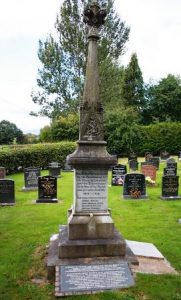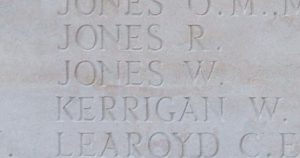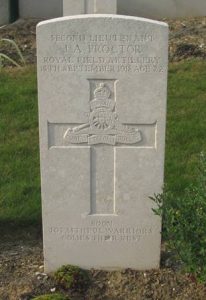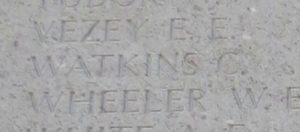Aberhafesp is a small village and community in Montgomeryshire, which includes the hamlet of Bwlch-y-Ffridd. It is situated about five miles west of Newtown on the B4568 close to the River Severn. The men of Aberhafesp who fell during the Great War are commemorated on the village war memorial, which is located in St. Gwynog’s Churchyard. There are five men named on the Aberhafesp war memorial who fell during the Great War, but I have taken the liberty of adding the details of other men of the village who are not named on the memorial. Beneath the memorial is another memorial, removed from the now closed Bwlchyffridd Congregational Church, following its closure in 2011. The second memorial commemorates three of the five fallen men on the main memorial, plus those who served and returned from the congregation of the former Church.

The Great War, 1914-1918
George Breese, Private, 355441, Royal Welsh Fusiliers. George was the son of George Samuel and Martha Breese, of Dysgwlfa, Aberhafesp. He worked as a Butler to Canon Woosnam at Aberhafesp Hall prior to enlisting into the Police Force on 11 July 1912. George had married Margaret Eleanor Evans on 20 June 1912, and the couple set up home at Pentre Cottage, Aberhafesp. George served as a Policeman at Newtown then at Welshpool prior to enlisting there into the Montgomery Yeomanry in July 1915. He was first posted to Ireland, and in January 1917 was posted to Egypt to join the 25th Battalion, Royal Welsh Fusiliers, which was attached to 231 Brigade, 74th (Yeomanry) Division. The Division had formed in Egypt in January 1917 and had fought through the Palestinian Campaign, at the Battles of Gaza and the Battle and capture of Jerusalem. George was accidentally killed in Palestine on 22 November 1917, aged 28, and is buried in Deir El Belah War Cemetery, Israel. He is also commemorated on the Dyfed Powys Police war memorial in Carmarthen.
Elijah Davies, Private, 65109, Welsh Regiment. Elijah was born in Aberhafesp in 1866, the son of John and Mary Davies. He had enlisted into the Welsh Regiment as a young man, in 1885 and served overseas for several years. Elijah re-enlisted into the Welsh Regiment following the outbreak of war and remained on home service until being discharged due to chronic arthritis on 15 January 1920. Elijah went to live at Newcastle Emlyn, Carmarthenshire, and died there soon after discharge, on 17 April 1920, aged 53. He is not commemorated by the CWGC. Elijah is not commemorated on the Aberhafesp memorial.
Richard Jenkins, Private, 65645, Royal Welsh Fusiliers. Richard was the son of John Jenkins and Sarah Jenkins. His father was from Aberhafesp, but had moved to Widnes to find work just prior to Richard’s birth in 1875. Richard married Ann Jane Sheppard in 1899, and the couple set up home at 29, Buxton Street, Seedley, Manchester. He enlisted at Manchester into the Royal Welsh Fusiliers, and because of his age was posted to the 7th (Garrison) Battalion, Royal Welsh Fusiliers, which formed in January 1917. Just a month later the battalion was dissolved, so Richard was posted to the Western Front, joining the 66th Company, Labour Corps. He was wounded whilst at work in the Ypres Salient, at the height of the Passchendaele offensive, and died at his wounds at Vlamertinghe on 6 November 1917, aged 43. Richard is buried in Vlamertinghe New Military Cemetery, Belgium. He is not commemorated on the Aberhafesp memorial.
John Maurice Jones, Private, 56991, Welsh Regiment. John was the son of David and Jane Jones, of Llwydcoed Mill, Aberhafesp. The family had moved to Penrhiew, Llanwnog just prior to the war and John worked for his father on the farm. John enlisted at Welshpool into the 3/1st Battalion, Montgomeryshire Yeomanry on 9 December 1915. The battalion was a reserve unit, which was formed at Welshpool in June 1915, before moving to Brecon, and then became attached to the 6th Reserve Cavalry Regiment at the Curragh, Ireland. Returning to Britain, in June 1916 the battalion became attached to 3rd Line Groups of Welsh Division at Gobowen and then Oswestry. John was then transferred to the 4th (Reserve) Battalion, Welsh Regiment before being drafted to France on 8 August 1916, joining the 10th Battalion, Welsh Regiment, which was attached to 114 Brigade, 38th (Welsh) Division. The Division was fresh from its epic assault on Mametz Wood and took over a section of the front at Hébuterne before moving to the Ypres Salient, taking over the Canal Bank sector at Boesinghe. The infantry battalions of the Division then began carrying out the normal pattern of rotation in the trenches, four days in the front, four in support and four in reserve, whilst also working on trench improvement, digging new trenches, and also carrying out regular patrols and trench raids. John was gassed on 22 July 1917, during the build up to the Divisions assault on Pilckem Ridge and was eventually evacuated back to Britain for treatment. He returned to France on 3 April 1918, and was posted to the 13th Battalion, Welsh Regiment, which was attached to 114 Brigade, 38th (Welsh) Division. The Division had just taken up positions north of Albert, around Aveluy Wood. Several minor offensives were launched over the coming weeks, to gain the high ground overlooking the Ancre valley, then on 21 August 1918 the division launched its assault across the River Ancre, capturing the German strongholds of Thiepval and Pozieres, before beginning their great advance across the old Somme battlefields towards the Hindenburg Line. John was wounded in the head on 1 September during the great advance and was repatriated home aboard the HS Grantully Castle to the 4th London General Hospital. He died there of his wounds on 17 October 1918, aged 25. His remains were brought home and he was buried in St. Gwynog’s Churchyard, Aberhafesp.
William Jones, Private, 43853, Royal Welsh Fusiliers. William was born on 4 November 1882, the son of Joseph and Elizabeth Jones, of Broombush, Penstrowed, Newtown. He married Rosa Jones on 5 May 1909, and the couple resided at Wain, Aberhafesp. William worked as a Quarryman prior to the war. He enlisted at Newtown into the Royal Welsh Fusiliers on 11 December 1915 and was posted to Kinmel Park for training. On 9 November 1916 William embarked for France, joining the 5th Infantry Base Depot, and on 9 November 1916 was posted to the 15th Battalion, Royal Welsh Fusiliers, which was at Ypres attached to 115 Brigade, 38th (Welsh) Division. Two weeks later he was transferred to the 2nd Battalion, Royal Welsh Fusiliers, which was on the Somme attached to 19 Brigade, 33rd Division and joined the battalion at Forceville, on 24 November. The battalion was resting and rebuilding following its efforts during the Somme offensive and moved via Mericourt for a camp at Vaux-sur-Somme before moving to another camp at Suzanne. At the beginning of April, the Division moved north to the Arras sector, and moved into trenches near Boiry-Becquerelle, at Croisilles, facing the Hindenburg Line. On 23 April 1917 the 2nd RWF, along with 19 Brigade, took part in assault on the Hindenburg Line, suffering heavy casualties during 24 hours of desperate fighting. The battalion moved back into reserve to rest and rebuild, before returning to the line in front of St. Leger on 18 May and the following day took part in another desperate attack. Again, the Hindenburg Line defences held, and the Allied assault was beaten off. The battalion then had another short break before launching another assault on the Hindenburg Line on 27 May 1917. William was posted as wounded and missing during a terrible day of desperate fighting. No trace of the 36-year-old was ever found, despite extensive enquiries, so he is recorded as having been killed in action on that date. The CWGC erroneously show his date of death as 27 May 1918. William is commemorated on the Pozieres Memorial, France. He is not commemorated on the Aberhafesp war memorial, but at nearby Mochdre.

Benjamin Phillips, Private, 355461, Royal Welsh Fusiliers. Benjamin was the son of Benjamin Phillips and Mary Ann Phillips (nee Breese), of Melinygloch, Aberhafesp. He worked as a labourer at Bettws prior to the war. Benjamin enlisted into the 3/1st Battalion, Montgomeryshire Yeomanry at Newtown on 11 December 1915 and was placed on the army reserve until being called up soon afterwards, on 22 January 1916. Benjamin joined the battalion at Oswestry, and after completing his training, embarked at Devonport for Egypt on 12 January 1917. Benjamin joined the 1/1st Battalion, Montgomeryshire Yeomanry on the Suez Canal defences. On 4 March 1917 the battalion merged with the Welsh Horse Yeomanry to form the 25th (Montgomery & Welsh Horse Yeomanry) Battalion, Royal Welsh Fusiliers, as part of the newly formed 231 Brigade, 74th (Yeomanry) Division. The Division then fought through the Palestinian Campaign, at the Battles of Gaza and the Battle and capture of Jerusalem. Due to the terrible casualties suffered by the British on the Western Front in March and April 1918 the Division was recalled to the Western Front, and arrived at Marseilles during May 1918. The Division trained near Le Cauroy before taking over positions in the St. Floris Sector, moving into the front line between the La Bassée Canal and the River Lys, with the left resting on the small village of Corbie. The Division faced the recently lost town of Merville, some 3,000 yards away. Benjamin was wounded when his battalion was following up a German withdrawal on 18 August. He was evacuated to the 39th Stationary Hospital at Aire, where he died of his wounds on 19 August 1918, aged 25. Benjamin is buried in Aire Communal Cemetery, France. His mother had by then moved to Ocean View, Dyffryn, Merionethshire.
James Adolphus Proctor, Second Lieutenant, Royal Field Artillery. James was born in Aberhafesp, the son of Edward Bernard and Helen Mary Proctor. The family later resided at Preswylfa, Aberdyfi. He originally served as a Gunner with the 5th Divisional Ammunition Column, Royal Field Artillery, and gained a commission into the Royal Field Artillery on 10 June 1918, joining the 402nd Battery, RFA. He joined the battery in France in time to take part in the great offensive, which was launched on 21 August 1918, following the Australian success at Villers-Bretonneux on 8 August, when the German will to fight was broken. James was wounded during the offensive, and died of his wounds on 18 September 1918, aged 22. He is buried in Marteville Communal Cemetery, Attilly, France. James is not commemorated on the Aberhafesp war memorial, but at Aberdyfi.

Charles Watkins, Private, 290864, Royal Welsh Fusiliers. Charles was an orphan who, together with his sister Rosa, were adopted by David and Eleanor Jones, of Llwydcoed Farm, Aberhafesp. He worked as a Waggoner prior to the war. Charles enlisted into the 7th Battalion, Royal Welsh Fusiliers at Newtown on 19 November 1914. The battalion was a Territorial unit, which mobilised for war at Newtown in August 1914, as part of North Wales Brigade, Welsh Division and moved to Conway until the end of the month, before moving to Northampton. In December the Division moved to Cambridge and then in May 1915 to Bedford, where the Division was numbered and the formation became 158 Brigade, 53rd (Welsh) Division. On 19 July 1915 the entire Division sailed from Devonport for Imbros and on 9 August 1915 landed at Suvla Bay. The infantry moved off the beaches into the bush, but due to a lack of maps and no knowledge of the terrain, many of the units became disorientated, and the situation became chaotic. The Division was eventually evacuated from Gallipoli in December 1915, moving to Egypt to join the EEF, and helped guard the Suez Canal before taking part in operations to drive the Turks out of the Sinai. The EEF then turned its attention onto driving the Turks out of Palestine, and on 26 March 1917 launched its first offensive against the coastal city of Gaza, which guarded the road to Jerusalem. Initial gains during the day were lost when the assaulting divisions lost touch with each other and communication broke down when a thick fog cloaked the battlefield. A second attempt to force Gaza was launched on 17 April, which also failed, and the EEF suffered a change in leadership, with Sir Edmund Allenby assuming command, before being re-organised, and a third offensive was launched against a wider front from Beersheba to Gaza on 31 October 1917. This time the Turkish defences were breached, and the road to Jerusalem now lay open and the EEF began to advance north. On 6 November 1917, 158 Brigade launched an attack on the Khuweilfeh Heights. Charles was killed in action during the fighting that day. The 24-year-old has no known grave and is commemorated on the Jerusalem Memorial, Israel.

Cyril Benjamin Whitticase, Private, 3241, Welsh Regiment. Cyril was the son of John and Ann Elizabeth Whitticase, of Glascoed, Aberhafesp. He worked on his father’s farm prior to the war. Cyril enlisted at Newtown into the 3/1st Battalion, Montgomeryshire Yeomanry, and was posted to the camp at Oswestry for training. During the spring of 1916 Cyril was posted to France, and was transferred to the 10th Battalion, Welsh Regiment, which was near Cuinchy, attached to 114 Brigade, 38th (Welsh) Division. The Division had been in France since December 1915, moving to the Nursery Sector near Fleurbaix for trench initiation, and over the coming months held various sectors of the line. During June 1916 the Division marched south to the Somme, and on 7 July 1916 attacked Mametz Wood. The initial attack failed, and it was three days later, on 10 July, that a fresh attack was mounted. After two days of heavy hand to hand fighting within the wood, the Germans withdrew, and the battered Welshmen moved via Hébuterne to Boesinghe, on the Yser Canal. The men of the 10th Welsh, comprised mainly of miners from the Rhondda, were attached to the 177th Tunnelling Company, Royal Engineers, and put to work digging and improving trenches and dugouts after their arrival at Boesinghe. The 177th TC had groups of men working on various projects at Ypres at the time, being aided by attached infantry from several divisions. Their detachment at Boesinghe was constructing a vast network of underground bunkers along the Canal Bank, one of which can be seen today, inside Boesinghe Industrial Estate. Cyril was at work on these dugouts, where the work had to be carried out at night, due to German artillery and machine-gun fire. He was killed in action here on 8 September 1916, aged 22. Cyril is buried in Vlamertinghe Military Cemetery, Belgium.
World War Two, 1939-1945
John Ernest Jones, Private, S/263025, Royal Army Service Corps. John was the son of David Edward and Alice Elizabeth Jones, of Aberhafesp. He married Emma Timmins at Cannock, in 1939. John enlisted into the Royal Army Service Corps, and was posted to North Africa with the 13th Field Bakery, RASC. Each Division of the British Army was equipped with a Field Bakery, and the bakeries were housed in motor lorries. John died in Egypt on 9 January 1943, aged 25. He is buried in Fayid War Cemetery, Egypt. There are no WW2 names on the Aberhafesp war memorial.
David Anthony Phillips, Leading Aircraftman, 945028, Royal Air Force Volunteer Reserve. David was the son of Gilbert Norton Phillips and Martha Louise Phillips, of Newtown. He enlisted into the Royal Air Force Volunteer Reserve, and was posted to Canada, to train as a pilot under the Empire Air Training Scheme. Upon arrival David was taken on strength at No. 2 Elementary Flying Training School at Fort William, Ontario, and was then posted to No. 4 Training Command at Penhold, Alberta, to train with No. 36 Service Flying Training School. On 24 December 1941, David and another student, Leading Aircraftman Bushell, were taking part in a cross country exercise, flying an Airspeed Oxford I, Serial AS523, when the aircraft struck trees and crashed near Red Deer, Alberta, seriously injuring both men. David died of his injuries two days later, on 26 December 1941, aged 20. His fellow student died of his injuries on 6 January 1942. David was cremated at Calgary Crematorium, and his cremated remains were later brought home from Calgary and buried in the family plot in St. Gwynog’s Churchyard, Aberhafesp on 16 May 1942. His parents were later buried with him. There are no WW2 names on the Aberhafesp memorial, but David is commemorated on the Newtown war memorial.